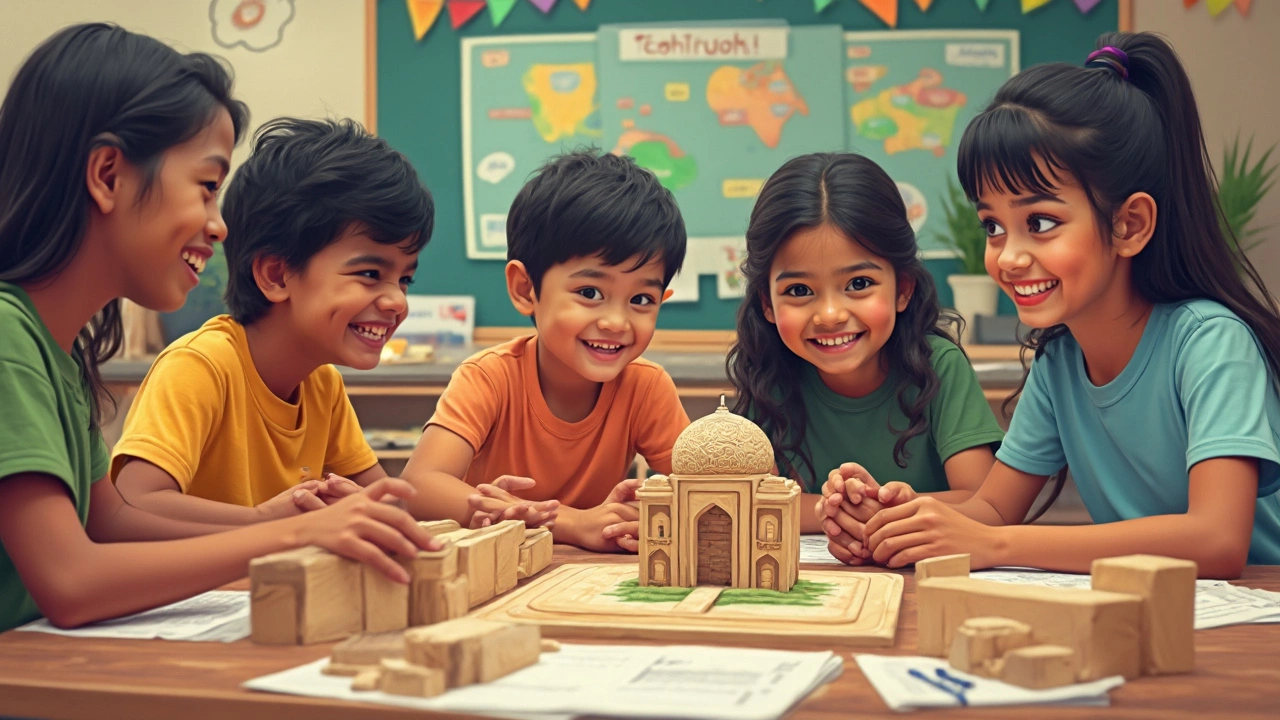Ever wonder what keeps kids excited about after-school hours? After-school clubs might just be the secret ingredient. They're a fantastic way for students to dive into activities they won't usually find in the regular curriculum. We're talking everything from tech-savvy robotics clubs to lively drama groups that bring out the budding performers in them.
The beauty of after-school clubs lies in their diversity. Whether a student is passionate about coding or painting, there's likely a club that caters to their interest. These clubs are more than just pastimes; they're pathways to developing important life skills. Plus, they're a great way to meet new friends who share similar hobbies.
Choosing the right club can be a game-changer for a student's school experience. It's about finding what sparks joy and curiosity. While some kids might thrive in competitive sports, others might prefer the quieter setting of a book club. The key is to explore options and see what fits best with their personality and interests.
- Understanding the Benefits of After-School Clubs
- Creative and Artsy Club Ideas
- STEM Clubs: Making Science and Tech Fun
- Sports and Physical Activity Clubs
- Clubs Focused on Social Skills and Teamwork
Understanding the Benefits of After-School Clubs
After-school clubs might seem like just a way to kill time after classes, but they're so much more than that. These clubs play a crucial role in the holistic development of students. Let's break down why they're such a big deal.
The Social Edge
One of the best parts about after-school clubs is their ability to boost social skills. When kids join clubs centered around shared interests, it's easier for them to make friends. Whether they're coding in a STEM club or painting in an art club, the sense of belonging is palpable.
Academic Benefits
Research suggests that students who participate in structured after-school programs tend to perform better academically. According to Jane Doe, a child development expert, "After-school clubs give kids a chance to apply what they've learned in school in practical settings. It makes learning fun and helps cement their understanding."
"These programs are crucial for enhancing a student’s learning experience outside traditional classrooms," - John Smith, Education Specialist.
Building Confidence
Participating in these activities also helps boost a kid's confidence. When students see themselves mastering a new skill, be it coding a simple game or playing a new sport, it gives their self-esteem a welcome lift.
Promoting Physical Health
While not every club is physical, those that involve sports or other active pursuits help students stay fit and healthy. In an age of increasing screen time, it's vital to get kids moving and engaged in physical activities.
Cultivating New Interests
After-school clubs also pave the way for discovering new passions. They offer a safe space for kids to experiment with various activities. Who knows? A student might discover their love for debate or an interest in extracurricular gardening.
A Glance at the Stats
| Benefit | Percentage of Improvement |
|---|---|
| Academic Performance | 20% |
| Social Skills | 30% |
| Physical Health | 25% |
Understanding these benefits helps us see why after-school activities should be a priority. They're not just about keeping kids busy; they're about enriching their lives in meaningful ways.
Creative and Artsy Club Ideas
Looking to unleash your kids' inner Picasso or Spielberg? Creative after-school activities can be the ticket. Schools offering such clubs give students a chance to express themselves and discover talents they never knew they had. It's not just about having fun—kids can gain skills that last a lifetime.
Art Club
Let's face it, not every classroom provides the time needed for budding artists to explore their craft. Enter the Art Club, where students can dive deeper into painting, sketching, or even crafting. Members can learn about famous artists and experiment with different media. And it's not just about individual projects—group murals are a hit and they promote teamwork.
Drama and Theater Club
For those with a flair for the dramatic, theater clubs are a perfect fit. Students can learn everything from acting technique to stage design. Plus, they get valuable public speaking skills while building confidence. Schools often end the year with a big performance, giving students the spotlight moment they crave.
Photography Club
In an age where smartphones double as cameras, photography clubs helps refine those shooting skills. Members learn about composition, lighting, and editing. With project-based assignments, like capturing school events or creating a photo journal, students have plenty of opportunities to showcase their work.
School Media Club
Turning students into storytellers, media clubs focus on skills like journalism, videography, and graphic design. Members often create school newspapers or podcasts. It's an opportunity to explore how media works while improving writing and editing skills along the way.
Creative clubs aren't just for students who already show an interest; they're excellent for anyone looking to try something new. Beyond artistic skills, kids learn patience, attention to detail, and the power of collaboration.

STEM Clubs: Making Science and Tech Fun
STEM clubs are where science, technology, engineering, and math come alive outside the classroom. These clubs give students a hands-on way to really dig into how things work, and they're a great place to foster a love for all things techy and sciencey.
One of the big draws of STEM clubs is their ability to make learning feel more like play. For instance, building robots not only teaches engineering principles but also encourages critical thinking and teamwork. It's not just about wires and circuits; it's about solving real-world problems creatively.
Robotics and Coding: Building the Future
Imagine students creating a robot that can navigate a maze or perform tasks. This isn't a sci-fi movie plot—it's what kids are doing in robotics clubs! These clubs often use popular kits like LEGO Mindstorms or Arduino to introduce the basics of coding and robotics.
"The best way to predict the future is to invent it," says Alan Kay, a computer science pioneer.
This quote resonates well, as these activities not only prepare students for future technology careers but also give them the chance to be innovative thinkers today.
Science Experiments: Curiosity in Action
STEM clubs also fuel the curious minds with fun science experiments. Students might perform simple chemical reactions or build small circuits. It's all about making those textbook concepts jump off the page and into life.
Data and Statistics Matter
According to a study from the National Math and Science Initiative, students who participate in STEM activities were 45% more likely to pursue a science or math degree in college. That's a significant bump that highlights just how impactful these clubs can be.
| STEM Activity | Skill Developed |
|---|---|
| Robotics | Problem-solving |
| Coding | Logical thinking |
| Science Experiments | Inquiry-based learning |
By joining a STEM club, students don't just learn—they experience science and tech in a way that opens up new worlds of opportunity. It's where knowledge meets fun, and that's a winning combo!
Sports and Physical Activity Clubs
Diving into sports and physical activity clubs is a fantastic way for students to blow off steam and stay active after school. Not only do these clubs provide essential physical exercise, but they also teach teamwork, discipline, and leadership. Whether it's soccer, basketball, or even yoga, there's something for every athletic interest.
One of the most popular after-school activities is the soccer club. This universal sport is great because it’s accessible and doesn't require tons of expensive equipment to get started. Plus, kicking a ball around with friends can really help build coordination and endurance.
Basketball clubs are another exciting option. With just a hoop and a ball, students can work on their skills, learn about strategy, and enhance their hand-eye coordination. Many schools even have tournament opportunities, which can be an exhilarating way to participate in a little friendly competition.
Off-the-Beaten-Path Options
Ever thought about trying something like rock climbing or martial arts? These are becoming increasingly popular among students who might not be into traditional team sports. Rock climbing clubs offer a full-body workout while teaching problem-solving skills, as climbers plan their routes on the wall. Meanwhile, martial arts clubs focus not only on physical endurance but also on discipline and focus, which are beneficial in many areas of life.
If outdoor activities are more appealing, running clubs can be a hit. They encourage students to set personal goals and track progress over time. Running requires minimal gear, which makes it an easy choice for most. And let's not forget about the benefit of fresh air while jogging through trails or local parks!
Embracing Team Spirit
Participating in club activities like these can promote a strong sense of community and school spirit. Being part of a team or a group working towards a common goal can be incredibly motivating. Plus, students are likely to make lifelong friends while they’re at it. There’s nothing quite like celebrating a win, no matter how big or small, with teammates who have worked just as hard.
Sports and physical activity clubs don’t just keep students fit—they also cultivate important life skills and values. For schools looking to engage students beyond the academic stuff, these clubs are a no-brainer.

Clubs Focused on Social Skills and Teamwork
Diving into the world of after-school activities that build social skills and teamwork can be a game-changer for students. These clubs help kids practice crucial social skills that aren't necessarily taught during school hours. They encourage cooperation, empathy, and the joy of working together towards a common goal.
Debate Clubs
Debate clubs are a great way for students to improve their communication and critical thinking skills. Participants learn to formulate arguments, listen to opposing views, and work in teams to prepare for competitions. These clubs teach participants how to convey their thoughts logically and persuasively, which is a valuable skill in any field.
Community Service Clubs
Community service clubs focus on helping others, fostering a sense of empathy and responsibility in students. Whether it's organizing a local food drive or participating in neighborhood clean-ups, these clubs get students involved in their community. They also show how teamwork can make a tangible impact, teaching important lessons about cooperation and civic duty.
Drama Clubs
Drama clubs aren't just about acting. They're about collaboration and trust. Students learn to express themselves and step into different roles, requiring them to understand various perspectives. It’s also a perfect opportunity to develop confidence and improve public speaking skills. Plus, there's the added benefit of having a blast doing improv or practicing for a school play.
Board Games & Strategy Clubs
In clubs like these, students learn the art of strategy and patience. Whether it's chess or strategic board games, these activities require quick thinking and cooperation with partners or teams. It's a fun and competitive way for students to engage their minds while practicing social interactions.
These after-school activities provide students with the foundation for building relationships and becoming effective team members. They offer a unique space to grow beyond traditional academic settings, combining learning with fun and personal development.





